North America Carbon Fiber Market Size
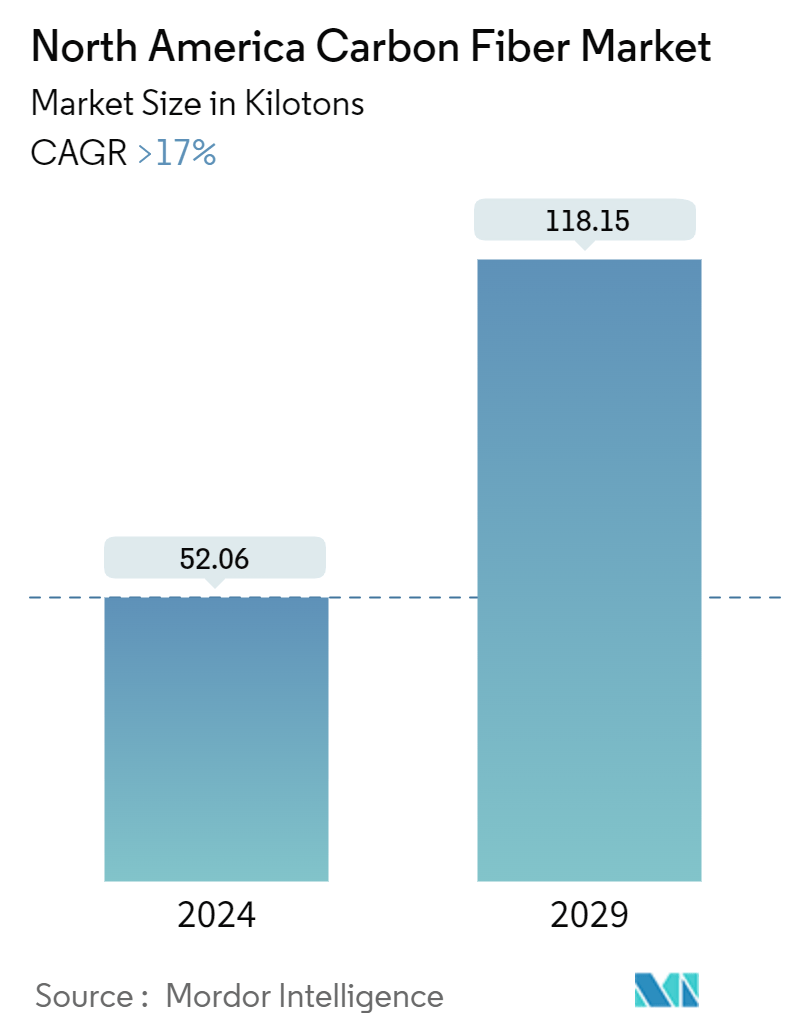
| Study Period | 2019 - 2029 |
| Base Year For Estimation | 2023 |
| Market Volume (2024) | 52.06 kilotons |
| Market Volume (2029) | 118.15 kilotons |
| CAGR (2024 - 2029) | > 17.00 % |
| Market Concentration | High |
Major Players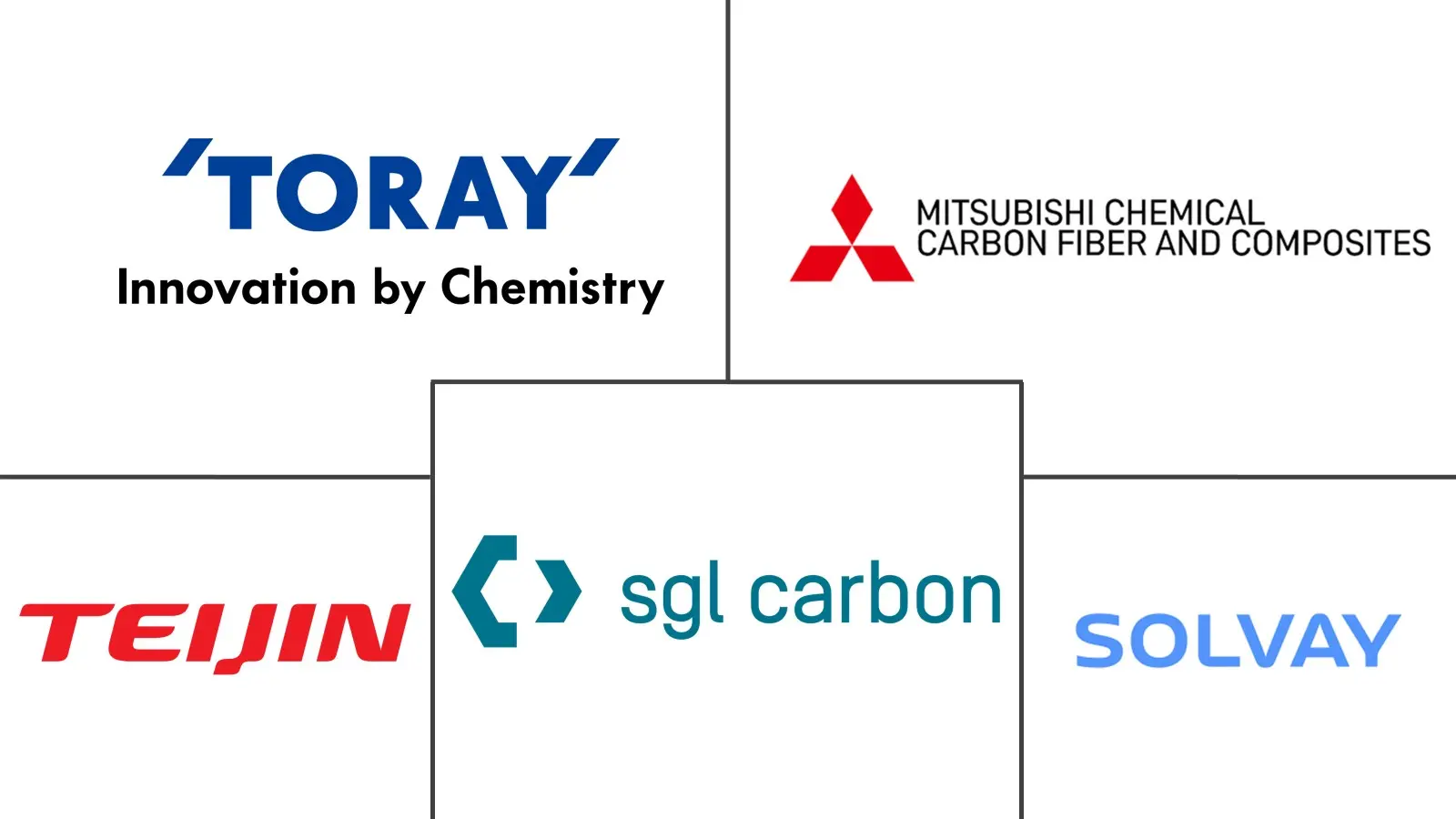
*Disclaimer: Major Players sorted in no particular order |
North America Carbon Fiber Market Analysis
The North America Carbon Fiber Market size is estimated at 52.06 kilotons in 2024, and is expected to reach 118.15 kilotons by 2029, growing at a CAGR of greater than 17% during the forecast period (2024-2029).
The COVID-19 pandemic disrupted the North American carbon fiber market. Lockdown measures, production halts, and reduced consumer spending led to a decline in demand for carbon fiber composites used in vehicle components, aircraft structures, and other applications. Many companies postponed or canceled orders for carbon fiber materials amid economic uncertainty. As lockdown measures were eased and economic activities resumed, the demand for carbon fiber in North America began to recover. Industries such as automotive, aerospace, and construction, which are significant consumers of carbon fiber, gradually resumed operations, driving demand for carbon fiber products.
• The increased demand for lighter and more fuel-efficient vehicles, increased use of carbon fiber in the aerospace and defense industries, and rise in the use of carbon fiber for renewable energy are the main factors driving the North American carbon fiber market.
• However, high investments in research and development activities in this sector and the availability of substitutes are expected to hinder the growth of the carbon fiber market.
• Opportunities for the future come from the growing demand for recycled carbon fiber and the increasing focus on using lignin as the primary raw material for carbon fiber.
• The United States had the most significant share of the market, and this is likely to stay valid for the upcoming years.
North America Carbon Fiber Market Trends
Aerospace and Defense Industry to Dominate the Market
- Carbon fiber is valued in the aerospace and defense sectors for its exceptional strength-to-weight ratio. Aircraft and defense systems require materials that are both strong and lightweight to maximize performance and fuel efficiency. Carbon fiber composites offer these characteristics, allowing manufacturers to reduce the weight of aircraft and defense equipment without compromising structural integrity or performance.
- Aerospace and defense applications often require materials that can endure extreme conditions like high temperatures, pressure, and mechanical stress. Carbon fiber composites exhibit excellent resistance to these factors, making them suitable for critical components such as aircraft fuselages, wings, rotor blades, and ballistic protection systems.
- The aerospace and defense sectors in North America represent significant markets for carbon fiber manufacturers. The demand from these industries often drives large-scale production facilities and investments in research and development. Companies in North America, including major aerospace manufacturers and defense contractors, have invested heavily in carbon fiber technology to meet the growing demand for lightweight and high-performance materials.
- According to the estimate released by the Aerospace Industries Association, the American aerospace and defense industry generated total sales of over USD 952 billion in 2022, which increased by almost 6.7% compared to 2021.
- Furthermore, according to the estimate released by the Aerospace Industries Association (AIA), aerospace and defense industry exports increased by 4.4% in 2022 to a total value of USD 104.8 billion.
- Aerospace and defense contracts typically involve long-term agreements and partnerships between manufacturers, suppliers, and government agencies. Carbon fiber suppliers often establish strategic relationships with aerospace and defense companies to secure long-term contracts for the supply of materials. These partnerships contribute to the dominance of the aerospace and defense industry in the North American carbon fiber market.
- In view of these factors, the aeronautics and defense sector is projected to prevail over the regional market during the forecast period, enabling the carbon fiber market in this region to grow at an exponential rate.
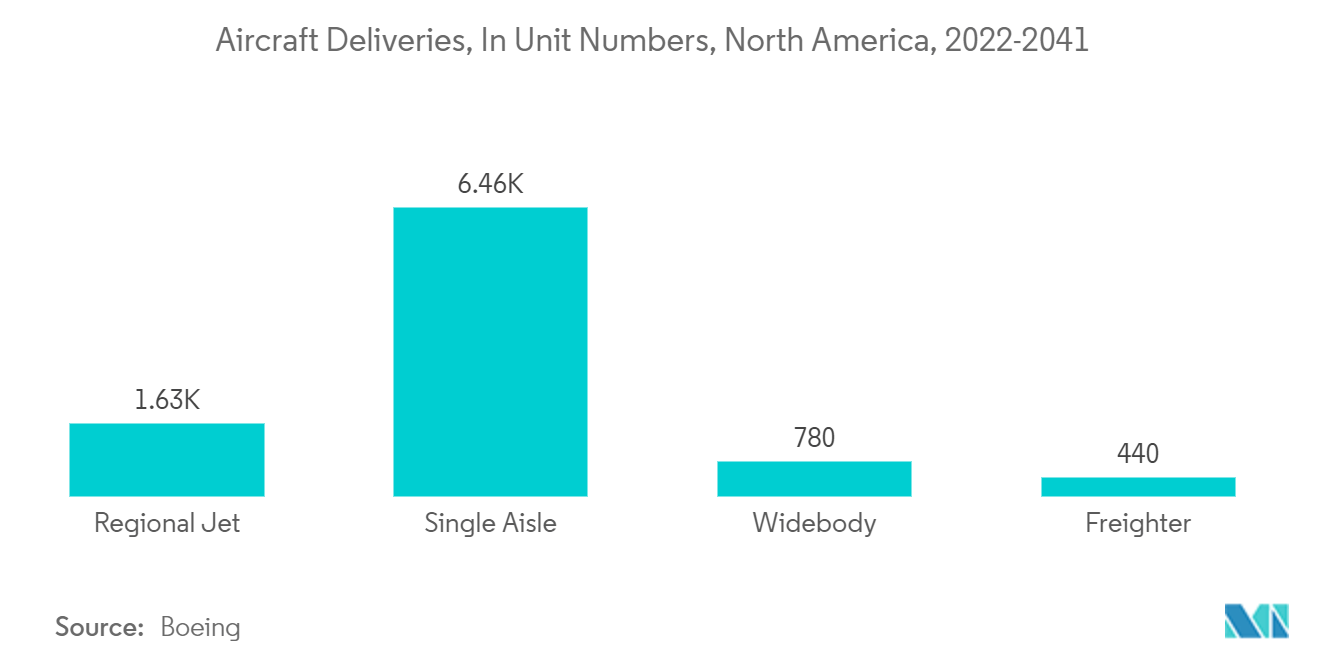
United States to Dominate the Market
- The United States is home to some of the world's largest and most advanced aerospace and defense companies, including Boeing, Lockheed Martin, Northrop Grumman, and Raytheon. These companies have significant demand for carbon fiber materials for aircraft, spacecraft, missiles, and defense systems.
- The United States has a robust research and development infrastructure focused on carbon fiber technology. Leading universities, national laboratories, and private research institutions conduct extensive research on carbon fiber materials, manufacturing processes, and applications. This investment in R&D contributes to innovation and technological advancements in the carbon fiber industry.
- According to the data released by the Bureau of Economic Analysis (BEA), the US automotive industry sold approximately 15.5 million units of light vehicles in 2023. Retail sales of about 3.12 million passenger cars and slightly over 12.4 million light vehicles were included in that number.
- The United States has a significant manufacturing base for carbon fiber materials and composites. Several major carbon fiber producers, including Hexcel Corporation, Toray Industries, and Solvay, have manufacturing facilities in the United States. These companies supply carbon fiber products to various industries, that include aerospace, automotive, wind energy, and sporting goods.
- Carbon fiber composites are majorly being used in the construction sector for applications such as reinforcing concrete structures, bridge components, and building facades. Carbon fiber reinforcement can enhance the strength, durability, and seismic resistance of infrastructure projects.
- According to the United States Census Bureau, USD 939.17 billion was spent on public construction in the US construction sector in 2022. Comparing 2022 to 2021, when the total amount spent on public construction was USD 365.32 billion, the construction sector showed a rise.
- In the coming years, all of these factors are expected to have a significant impact on the demand for carbon fiber in this region.
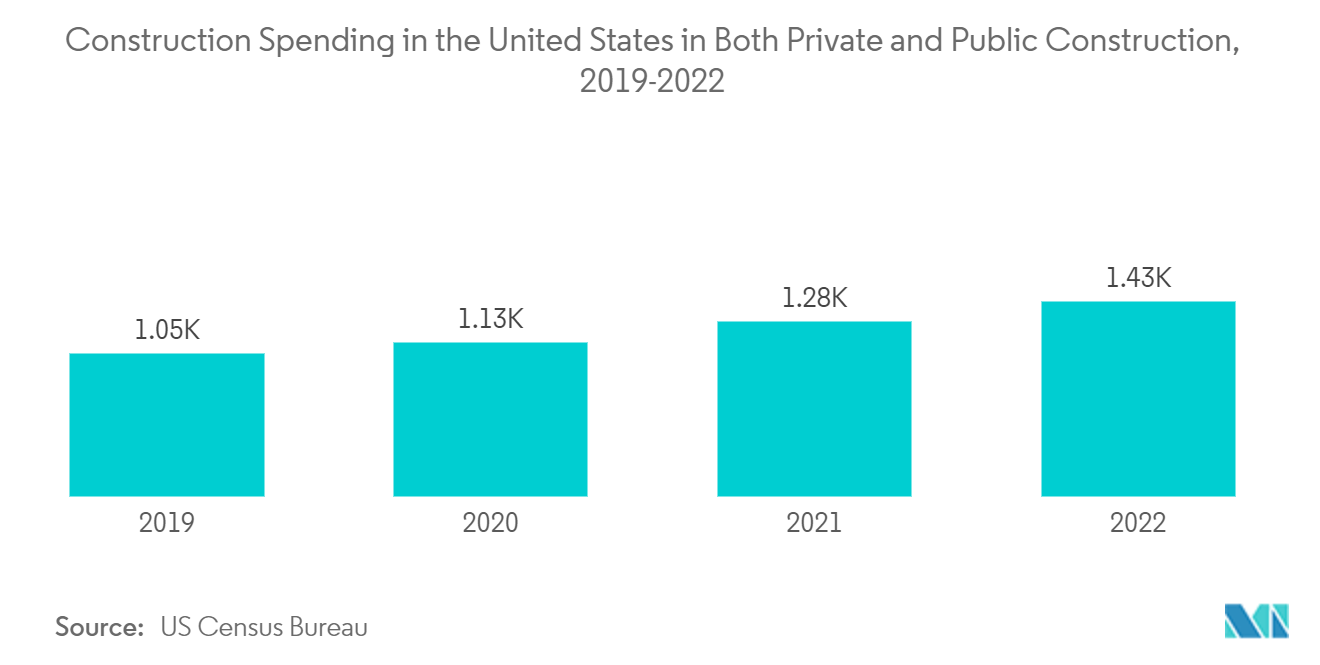
North America Carbon Fiber Industry Overview
The North American carbon fiber market is highly consolidated. The major companies include (not in particular order) Mitsubishi Chemical Carbon Fiber and Composites Inc., SGL Carbon, Solvay, TEIJIN LIMITED, and Toray Industries Inc.
North America Carbon Fiber Market Leaders
-
Mitsubishi Chemical Carbon Fiber and Composites Inc.
-
SGL Carbon
-
Solvay
-
TEIJIN LIMITED
-
Toray Industries, Inc.
*Disclaimer: Major Players sorted in no particular order
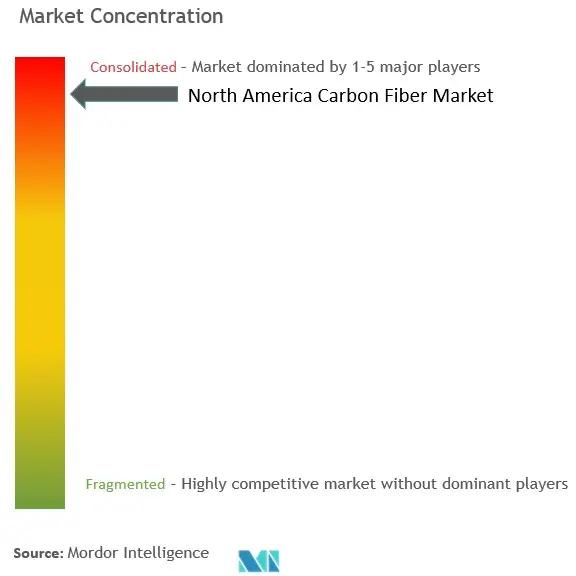
North America Carbon Fiber Market News
- March 2023: SGL Carbon launched SIGRAFIL 50k carbon fiber. This is majorly used in the wind and automotive industries, among others. It has high levels of strength of 4.9 GPa and elongation of 2.0 %. The advantages of SIGRAFIL 50k fiber types are increased process efficiency, higher material throughput, faster process times, and less set-up effort.
- April 2022: Hexcel Corporation and Archer Aviation Inc. announced their collaboration to supply high-performance carbon fiber material that would be used to manufacture Archer's production aircraft.
- January 2022: Vartega, a US-based company, announced the employment of a new technology for the recycling of carbon fiber waste for the management of carbon fiber waste in the country. The company will be using a patented chemical-based process to rescue carbon fiber waste from an eternity in the landfill.
North America Carbon Fiber Market Report - Table of Contents
1. INTRODUCTION
1.1 Study Assumptions
1.2 Scope of the Study
2. RESEARCH METHODOLOGY
3. EXECUTIVE SUMMARY
4. MARKET DYNAMICS
4.1 Drivers
4.1.1 Increasing Demand for Fuel-efficient and Lightweight Vehicles
4.1.2 Accelerating Usage in the Aerospace and Defense Sector
4.1.3 Increasing Usage in Renewable Energy
4.2 Restraints
4.2.1 High R&D Investments
4.2.2 Other Restraints
4.3 Industry Value-Chain Analysis
4.4 Porter's Five Forces Analysis
4.4.1 Bargaining Power of Suppliers
4.4.2 Bargaining Power of Consumers
4.4.3 Threat of New Entrants
4.4.4 Threat of Substitute Products and Services
4.4.5 Degree of Competition
5. MARKET SEGMENTATION (Market Size in Volume)
5.1 By Raw Material
5.1.1 Polyacrtlonitrile (PAN)
5.1.2 Petroleum Pitch and Rayon
5.2 By Type
5.2.1 Virgin Fiber (VCF)
5.2.2 Recycled Fiber (RCF)
5.3 By Application
5.3.1 Composite Materials
5.3.2 Textiles
5.3.3 Microelectrodes
5.3.4 Catalysis
5.4 By End-user Industry
5.4.1 Aerospace and Defense
5.4.2 Alternative Energy
5.4.3 Automotive
5.4.4 Construction and Infrastructure
5.4.5 Sporting Goods
5.4.6 Other End-user Industries (Marine and Maritime)
5.5 By Geography
5.5.1 United States
5.5.2 Canada
5.5.3 Mexico
5.5.4 Rest of North America
6. COMPETITIVE LANDSCAPE
6.1 Mergers & Acquisitions, Joint Ventures, Collaborations, and Agreements
6.2 Market Share (%)**/ Ranking Analysis
6.3 Strategies Adopted by Leading Players
6.4 Company Profiles
6.4.1 A&P Technology Inc.
6.4.2 DowAksa
6.4.3 Formosa M Co. Ltd
6.4.4 Hexcel Corporation
6.4.5 Hyosung Advanced Materials
6.4.6 Mitsubishi Chemical Carbon Fiber and Composites Inc.
6.4.7 Present Advanced Composites Inc.
6.4.8 SGL Carbon
6.4.9 Solvay
6.4.10 TEIJIN LIMITED
6.4.11 Toray Industries Inc.
6.4.12 Vartega Inc.
- *List Not Exhaustive
7. MARKET OPPORTUNITIES AND FUTURE TRENDS
7.1 Increasing Popularity of Recycled Carbon Fiber
7.2 Emphasis on Usage of Lignin as Raw Material for Carbon Fiber
North America Carbon Fiber Industry Segmentation
Carbon fiber is a high-strength synthetic fiber composed mainly of carbon atoms. It is known for its exceptional strength-to-weight ratio, stiffness, and chemical resistance, which makes it a popular material in various industries. Carbon fiber is produced through a series of processes involving the conversion of carbon-rich precursors.
The North American carbon fiber market is segmented by raw material, type, application, end-user industry, and geography. By raw material, the market is segmented into polyacrylonitrile (PAN), petroleum pitch, and rayon. By type, the market is segmented into virgin fiber (VCF) and recycled carbon fiber (RCF). The applications of carbon fiber comprise composite materials, textiles, microelectrodes, and catalysis. By end-user industry, the market is segmented into aerospace and defense, alternative energy, automotive, construction and infrastructure, sporting goods, and other end-user industries (marine and maritime). The report also covers the market size and forecasts for the carbon fiber market in three countries across North America. For each segment, the market sizing and forecasts were made based on volume (tons).
| By Raw Material | |
| Polyacrtlonitrile (PAN) | |
| Petroleum Pitch and Rayon |
| By Type | |
| Virgin Fiber (VCF) | |
| Recycled Fiber (RCF) |
| By Application | |
| Composite Materials | |
| Textiles | |
| Microelectrodes | |
| Catalysis |
| By End-user Industry | |
| Aerospace and Defense | |
| Alternative Energy | |
| Automotive | |
| Construction and Infrastructure | |
| Sporting Goods | |
| Other End-user Industries (Marine and Maritime) |
| By Geography | |
| United States | |
| Canada | |
| Mexico | |
| Rest of North America |
North America Carbon Fiber Market Research FAQs
How big is the North America Carbon Fiber Market?
The North America Carbon Fiber Market size is expected to reach 52.06 kilotons in 2024 and grow at a CAGR of greater than 17% to reach 118.15 kilotons by 2029.
What is the current North America Carbon Fiber Market size?
In 2024, the North America Carbon Fiber Market size is expected to reach 52.06 kilotons.
Who are the key players in North America Carbon Fiber Market?
Mitsubishi Chemical Carbon Fiber and Composites Inc., SGL Carbon, Solvay, TEIJIN LIMITED and Toray Industries, Inc. are the major companies operating in the North America Carbon Fiber Market.
What years does this North America Carbon Fiber Market cover, and what was the market size in 2023?
In 2023, the North America Carbon Fiber Market size was estimated at 43.21 kilotons. The report covers the North America Carbon Fiber Market historical market size for years: 2019, 2020, 2021, 2022 and 2023. The report also forecasts the North America Carbon Fiber Market size for years: 2024, 2025, 2026, 2027, 2028 and 2029.
North America Carbon Fiber Industry Report
Statistics for the 2024 North America Carbon Fiber market share, size and revenue growth rate, created by ����vlog��ý™ Industry Reports. North America Carbon Fiber analysis includes a market forecast outlook 2029 and historical overview. Get a sample of this industry analysis as a free report PDF download.



